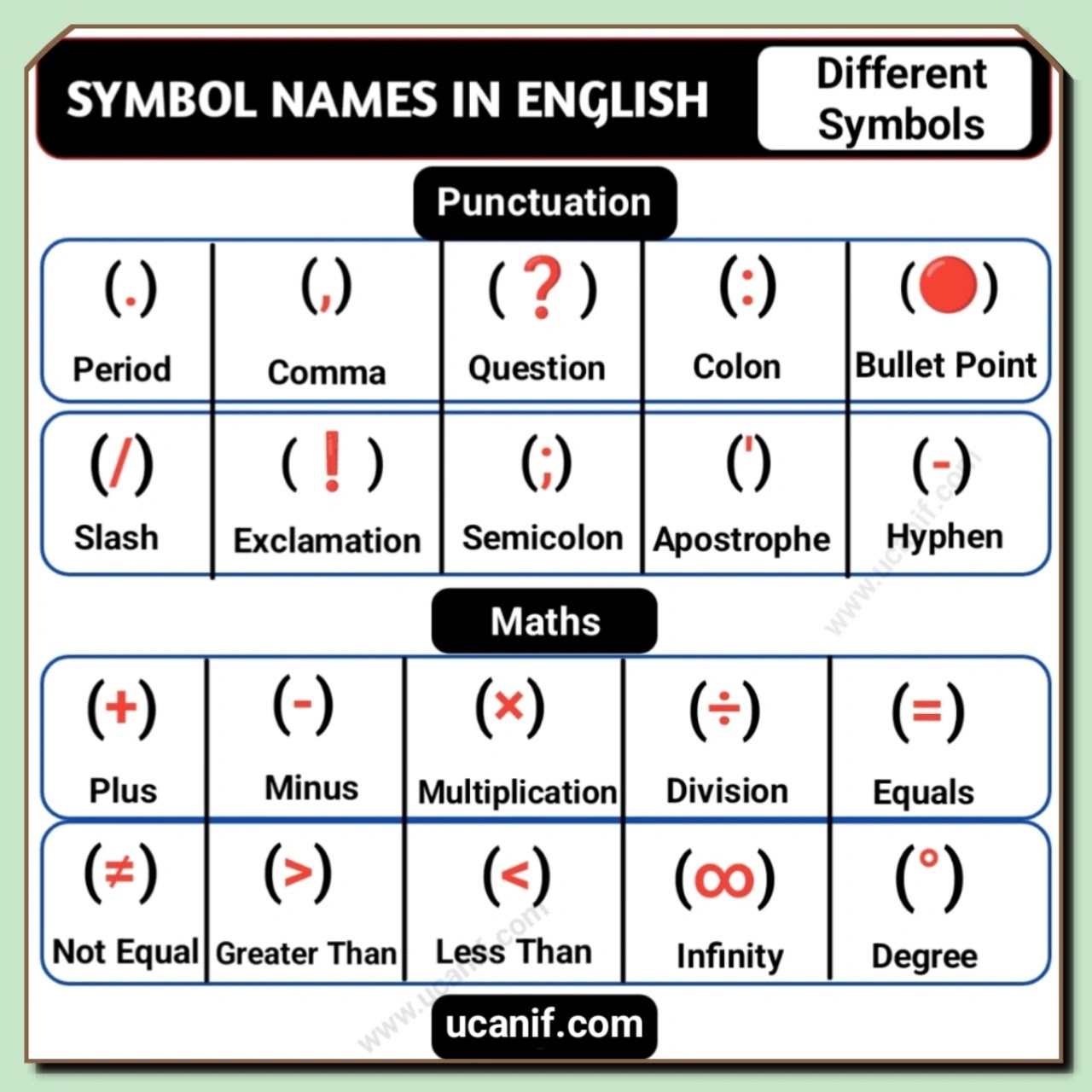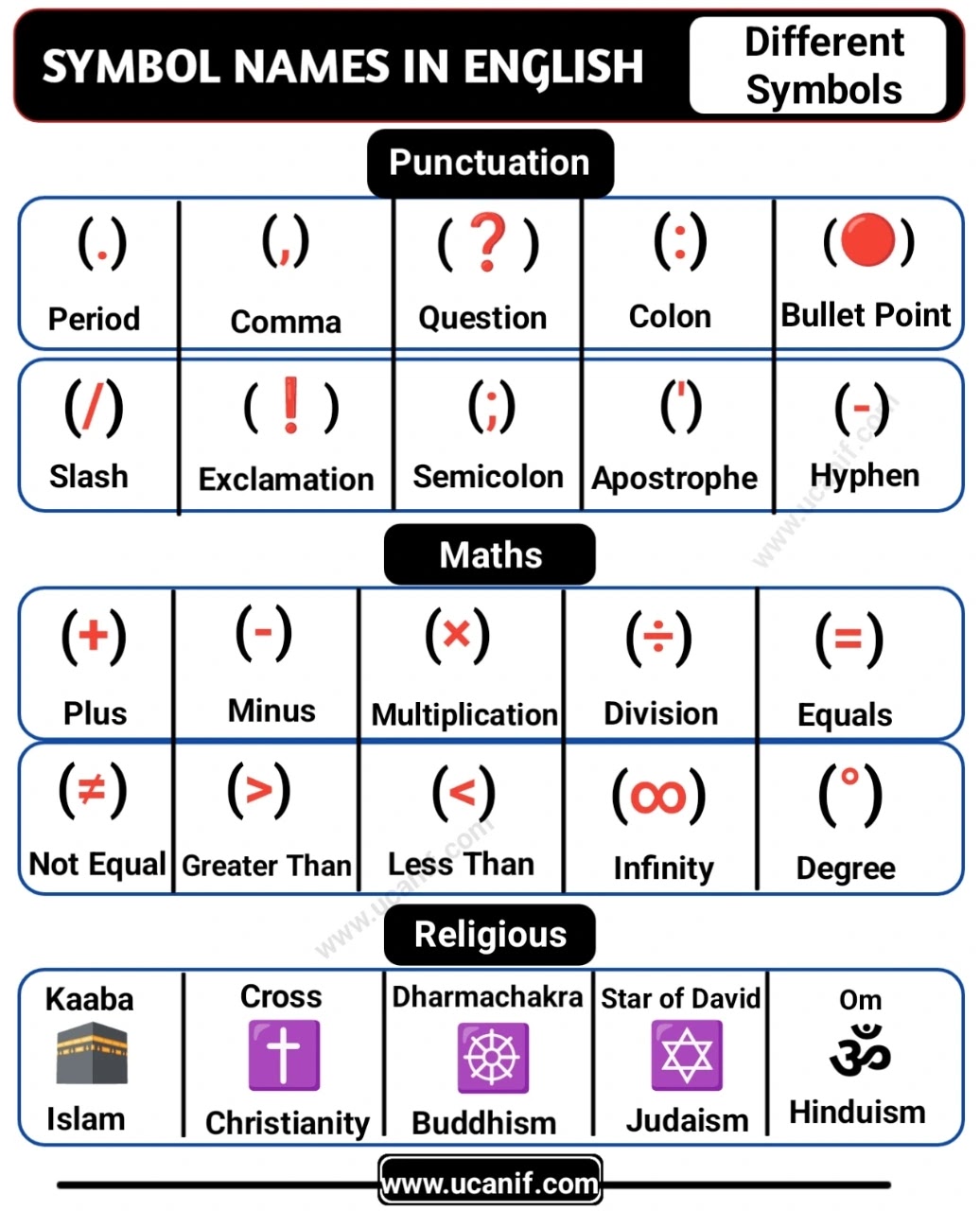100+ List of Symbols Name in English You Should Know
In the realm of communication, symbols hold the power to transcend language barriers and convey profound meanings. This article dives into the fascinating landscape of symbols, shedding light on their names across various contexts.
From the world of mathematics to religious symbolism, explore the richness of “Symbols Name in English” and discover how these visual elements shape our understanding of the world.
73 Common Symbols Name in English
Here’s a list of common symbols along with their names in English:
- Ampersand (&): Represents the word “and.”
- Asterisk (*): Used to indicate a footnote or to emphasize a point.
- At Symbol (@): Used in email addresses and social media handles.
- Dollar Sign ($): Represents currency, particularly the US dollar.
- Hash/Hashtag (#): Used for categorizing content on social media.
- Percentage/Percent Sign (%): Represents a percentage or portion.
- Question Mark (?): Denotes a question or inquiry.
- Exclamation Mark (!): Used to express strong emotion or emphasis.
- Plus Sign (+): Represents addition or inclusion.
- Minus Sign (-): Represents subtraction or removal.
- Equal Sign (=): Indicates equality or equivalence.
- Greater Than Sign (>): Represents a value larger than another.
- Less Than Sign (<): Represents a value smaller than another.
- Slash (/): Used in fractions, dates, and URLs.
- Backslash (): Used to indicate file paths in computer systems.
- Tilde (~): Used to indicate approximation or similarity.
- Vertical Bar/Pipe (|): Used in programming and design for various purposes.
- Colon (:): Used to introduce lists, explanations, or dialogues.
- Semicolon (;): Used to connect related independent clauses.
- Quotation Marks (” “): Used to enclose direct speech or quotes.
- Parentheses ( ): Used to enclose extra information or clarify context.
- Brackets [ ]: Used to enclose explanations or modifications.
- Curly Braces { }: Used in programming to group elements.
- Underscore (_): Used in filenames, email addresses, and coding.
- Ellipsis (…): Indicates omission or continuation of a thought.
- Copyright Symbol (©): Represents ownership or copyright.
- Trademark Symbol (™): Indicates trademarked names or products.
- Registered Trademark Symbol (®): Indicates registered trademarks.
- Degree Symbol (°): Represents temperature, angles, or geographic coordinates.
- Plus-Minus Symbol (±): Indicates a range of values or uncertainty.
- Infinity Symbol (∞): Represents limitless or unbounded concepts.
- Square Root Symbol (√): Represents the square root of a number.
- Caret Symbol (^): Used in mathematics to indicate exponentiation.
- Registered Trademark Symbol (®): Indicates that a trademark is officially registered.
- Bullet Point (•): Used to create lists or emphasize items.
- Smiley Face Emoji (😊): Conveys happiness or positive emotions.
- Sad Face Emoji (😔): Conveys sadness or disappointment.
- Heart Symbol (❤️): Represents love and affection.
- Star Symbol (★): Used to indicate excellence or importance.
- Check Mark Symbol (✓): Signifies correctness or completion.
- Cross Mark Symbol (❌): Indicates an incorrect or prohibited action.
- Peace Symbol (☮): Represents peace and harmony.
- Sun Symbol (☀️): Represents sunlight, warmth, and positivity.
- Moon Symbol (🌙): Signifies the moon or nighttime.
- Telephone Symbol (☎️): Represents a telephone or communication.
- Envelope Symbol (✉️): Represents an email or message.
- Camera Symbol (📷): Represents photography or capturing moments.
- Greek Alpha Symbol (α): The first letter of the Greek alphabet.
- Greek Omega Symbol (ω): The last letter of the Greek alphabet.
- Pilcrow Symbol (¶): Used to indicate a new paragraph or section.
- Section Symbol (§): Used to reference a specific section of a document or law.
- Currency Euro Symbol (€): Represents the euro currency.
- Currency Pound Symbol (£): Represents the British pound currency.
- Currency Yen Symbol (¥): Represents the Japanese yen currency.
- Currency Rupee Symbol (₹): Represents the Indian rupee currency.
- Currency Dollar Symbol ($): Represents other unspecified currency units.
- Roman Numeral I (I), II (II), III (III), etc.: Used in counting and naming.
- Registered Sign (®): Indicates a registered trademark.
- Unregistered Sign (™): Indicates an unregistered trademark.
- Celsius Symbol (℃): Represents degrees Celsius.
- Fahrenheit Symbol (℉): Represents degrees Fahrenheit.
- Prime Symbol (′): Used to denote differentiation or measurement.
- Double Prime Symbol (″): Denotes seconds, as in feet or inches.
- Dagger Symbol (†): Used for footnotes or references.
- Double Dagger Symbol (‡): Represents a second-level footnote.
- Paragraph Symbol (§): Indicates a section of a document.
- Cross Symbol (✝️): Represents Christianity or religion.
- Star of David Symbol (✡️): Symbolizes Judaism.
- Crescent Moon Symbol (🌙): Represents the lunar phase.
- Cloud Emoji (☁️): Depicts clouds or weather conditions.
- Umbrella Emoji (☂️): Represents protection from rain.
- Lightning Bolt Emoji (⚡️): Symbolizes electricity or energy.
Punctuation Symbols Name in English
Here are some common punctuation symbols name in English:
- Period (.): Indicates the end of a sentence.
- Comma (,): Separates items in a list or separates clauses.
- Question Mark (?): Indicates a question.
- Exclamation Mark (!): Indicates strong emotion or emphasis.
- Colon (:): Introduces a list, explanation, or quotation.
- Semicolon (;): Separates related independent clauses or items in a list.
- Quotation Marks (” ” or ‘ ‘): Encloses direct speech or quotes.
- Apostrophe (‘): Indicates possession or contraction.
- Hyphen (-): Joins words or parts of words, indicates ranges, or links compounds.
- En Dash (–): Indicates a range, such as in numbers or dates.
- Em Dash (—): Separates clauses or provides emphasis.
- Parentheses ( ): Encloses additional information or separates content.
- Brackets [ ]: Encloses explanatory or modifying material.
- Curly Braces { }: Used in programming or to group items.
- Ellipsis (…): Indicates omission or continuation of a thought.
- Slash (/): Separates options, alternatives, or in fractions.
- Backslash (): Used in file paths or programming.
- *Bullet Point (•): Indicates items in a list.
- Number Sign (#): Used in numbers, social media hashtags, or music notation.
- Ampersand (&): Represents “and” and is often used in abbreviations.
- At Symbol (@): Used in email addresses and social media handles.
- Dollar Sign ($): Represents currency, particularly dollars.
- Percent Sign (%): Represents a percentage or portion.
- Copyright Symbol (©): Represents copyright ownership.
- Registered Trademark Symbol (®): Indicates a registered trademark.
- Trademark Symbol (™): Denotes a trademark.
- Section Symbol (§): Used to reference a section or paragraph.
- Plus-Minus Symbol (±): Represents a range of values or uncertainty.
Maths Symbols Name in English
Here are some common math symbols name in English:
- Plus Sign (+): Indicates addition.
- Minus Sign (-): Represents subtraction or negative numbers.
- *Multiplication Sign (×): Represents multiplication.
- Division Sign (÷ or /): Represents division.
- Equals Sign (=): Indicates equality between two expressions.
- Greater Than Sign (>): Represents greater than or more than.
- Less Than Sign (<): Represents less than or fewer than.
- Greater Than or Equal To (≥): Represents greater than or equal to.
- Less Than or Equal To (≤): Represents less than or equal to.
- Not Equal To (≠): Indicates not equal to.
- Percent Sign (%): Represents a percentage or proportion.
- Square Root Symbol (√): Represents the square root of a number.
- Cubic Root Symbol (³√): Represents the cube root of a number.
- Pi Symbol (π): Represents the mathematical constant pi.
- Infinity Symbol (∞): Represents an unbounded value or concept.
- Approximately Equal To (≈): Indicates an approximation.
- Degree Symbol (°): Represents angles or temperature in degrees.
- Parallel Lines (||): Represents lines that are always equidistant and never meet.
- Perpendicular Lines (⊥): Represents lines that intersect at a right angle.
- Vertical Line (|): Represents a vertical direction or separation.
- Horizontal Line (—): Represents a horizontal direction or separation.
- Fraction Bar (⁄): Separates the numerator and denominator in a fraction.
- Summation Symbol (∑): Represents the sum of a series.
- Product Symbol (∏): Represents the product of a series.
- Integral Symbol (∫): Represents the integral of a function.
- Derivative Symbol (d/dx): Represents the derivative of a function.
- Right Angle Symbol (⦜): Represents a right angle.
Religious Symbols Name in English
Here are some common religious Symbols Name in English:
- Cross (✝️): A symbol of Christianity, representing the crucifixion and resurrection of Jesus Christ.
- Star of David (✡️): A symbol of Judaism, often associated with Jewish identity and faith.
- Crescent Moon and Star (☪️): A symbol of Islam, representing the faith and it is important to note that this symbol is not mentioned in the Quran as an official emblem of Islam, it has become a widely recognized representation of the faith.
- Om Symbol (ॐ): A sacred sound and spiritual icon in Hinduism, Buddhism, and Jainism.
- Ankh (☥): An ancient Egyptian symbol representing life, immortality, and divinity.
- Lotus Flower (🌸): A symbol of purity, enlightenment, and rebirth in various Eastern religions.
- Ichthys (Fish Symbol) (🐟): A secret symbol used by early Christians, symbolizing Christ.
- Dharma Wheel (Dharmachakra) (☸️): A Buddhist symbol representing the teachings of Buddha.
- Menorah (🕎): A seven-branched candelabrum symbolizing the Jewish faith and Hanukkah.
- Hamsa Hand (🖐️): A protective symbol in various cultures, representing blessings and power.
- Yin and Yang (☯️): A symbol of balance and harmony in Taoism.
- Triquetra (🔱): A Celtic knot symbolizing unity, eternity, and the Holy Trinity.
- Thor’s Hammer (Mjölnir) (🔨): An ancient Norse symbol representing protection and strength.
- Pentagram (⭐): A five-pointed star often associated with various spiritual beliefs.
As we conclude our exploration across the various realms of “Symbols Name in English,” we recognize the universal significance that these visual representations hold.
From the everyday “Common Symbol Name in English” that pepper our interactions to the precise “Punctuation Symbols name in English” that structure our language, each mark and shape serves a purpose far beyond its appearance.
By journeying through the “Maths symbols name in English,” we grasp the language of numbers and equations, deciphering the logic that underpins the mathematical universe.
Venturing further into the terrain of “Religious Symbols Name in English,” we acknowledge the profound connections between faith, culture, and these sacred visuals.
Through our journey across the canvas of “Symbols Name in English,” we’ve uncovered layers of significance that enrich our understanding of language, culture, and the universal ties that bind us.
In essence, the thread that weaves through the sections of “Common Symbol Name in English,” “Punctuation Symbols name in English,” “Maths symbols name in English,” and “Religious Symbols Name in English” is the recognition that these symbols transcend linguistic confines.



